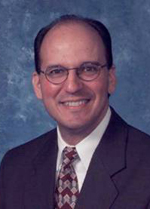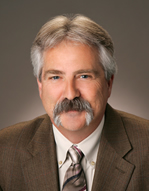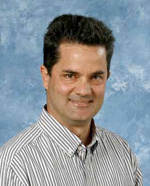Infiniband Exceeds High-Speed TCP/IP
Researchers at the Energy Department's Oak Ridge National Laboratory have shown that InfiniBand can be used to transport large datasets via a dedicated network thousands of miles in length with a throughput unmatched by high-speed TCP/IP connections.
CSMD researcher Nageswara Rao presented a paper on the group's work, "Wide-Area Performance Profiling of 10GigE and InfiniBand Technologies," at the SC08 conference in November.
Rao said difficulties abound with large data transfers over high-speed wide-area networks, including packet conversion from storage networks and the complex task of TCP/IP tuning. "The task of sustaining end-to-end throughput…over thousands of miles still remains complex," the researchers wrote in the paper.
The full article at Government Computing News can be seen HERE.
The HPCwire summary can be seen HERE.
Erickson Serves as Committee Member for National Academy of Science Investigation
David Erickson, a Senior Scientist in ORNL's Computational Earth Sciences group, served as a committee member on the National Academy of Sciences' recent study to develop a better understanding of the potential scientific and technological impact of high-end capability computing (HECC) in fields of science and engineering of interest to the Federal government.
The fields chosen for the study were the atmospheric sciences, astrophysics, chemical separations, and evolutionary biology. The committee found continuing demands from the four fields for more, and more powerful, high-end computing. All four areas rely on HECC to carry out simulations of systems that are too complex to analyze through observation, experiment, or theory. Three of the four areas (the exception being chemical separations) are dealing with very large amounts of data and need HECC to handle them.
The report from this study "The Potential Impact of High-End Computing on Illustrative Fields of Science and Engineering," can be seen HERE.
Tony Mezzacappa Named Editor-in-Chief - Computational Science & Discovery
 Non-profit scientific publisher Institute of Physics Publishing (IOP), UK, has announced the launch of a new journal - Computational Science & Discovery. The journal will focus on scientific advances and discovery through computational science in physics, chemistry, biology and applied science. Tony Mezzacappa of the Oak Ridge National Laboratory serves as the Editor-in-Chief of the journal. Non-profit scientific publisher Institute of Physics Publishing (IOP), UK, has announced the launch of a new journal - Computational Science & Discovery. The journal will focus on scientific advances and discovery through computational science in physics, chemistry, biology and applied science. Tony Mezzacappa of the Oak Ridge National Laboratory serves as the Editor-in-Chief of the journal.
Computational Science & Discovery will publish original, peer-reviewed research across physics, chemistry, biology and applied science. The journal offers an opportunity for researchers to publish all the important components of their enterprise, together with their scientific results.
The first issue is currently available online at http://www.iop.org/EJ/toc/1749-4699/1/1.
Jaguar simulation wins Gordon Bell Prize
A team led by the Computer Science & Mathematics Division's Thomas Schulthess received the prestigious 2008 Association for Computing Machinery Gordon Bell Prize Thursday after attaining the fastest performance ever in a scientific supercomputing application.
Thomas is group leader of ORNL's Computational Materials Science Group and recently accepted a position as director of the Swiss National Supercomputing Center at Manno, an institution of ETH Zurich. He and colleagues Thomas Maier, Michael Summers and Gonzalo Alvarez, all of ORNL, achieved 1.352 quadrillion calculations a second—or 1.352 petaflop - on ORNL's Cray XT Jaguar supercomputer with a simulation of superconductors, or materials that conduct electricity without resistance. By modifying the algorithms and software design of its DCA++ code to maximize speed without sacrificing accuracy, the team was able to boost performance tenfold with the help of John Levesque and Jeff Larkin of Cray Inc.
The team's simulation made efficient use of 150,000 of Jaguar's 180,000-plus processing cores to explore electrical conductance.
To put the achievement into perspective, it would take every man, woman and child on earth more than 500 years to work through as many calculations as DCA++ gets through in a single day - and that's assuming each of us worked day and night solving one calculation a second. More details.
Maccabe named director of Computer Science and Mathematics Division
 Arthur Bernard (“Barney”) Maccabe, a professor of computer science and chief information officer at the University of New Mexico, will direct the Computer Science and Mathematics (CSM) Division at Oak Ridge National Laboratory (ORNL), Associate Laboratory Director for Computing and Computational Sciences Thomas Zacharia has announced. Through advanced computing research, CSM supports national priorities in partnership with industry and academia and has programs in basic and applied research in the computational sciences, information technologies, and intelligent systems. Maccabe’s appointment will be effective Jan. 5. Arthur Bernard (“Barney”) Maccabe, a professor of computer science and chief information officer at the University of New Mexico, will direct the Computer Science and Mathematics (CSM) Division at Oak Ridge National Laboratory (ORNL), Associate Laboratory Director for Computing and Computational Sciences Thomas Zacharia has announced. Through advanced computing research, CSM supports national priorities in partnership with industry and academia and has programs in basic and applied research in the computational sciences, information technologies, and intelligent systems. Maccabe’s appointment will be effective Jan. 5.
On the faculty of the University of New Mexico since 1982, Maccabe is an expert in “lightweight” system software for massively parallel computing systems. In contrast to full-featured operating systems, lightweight operating systems have minimal features, improving the ability of software to scale for use on systems employing thousands of processors.
View official announcement.
ORNL Group Leader Appointed Swiss National Supercomputing Centre Director
 Thomas Schulthess (former Group leader of ORNL's Computational Materials Science Group) is the new Director of the Swiss National Supercomputing Centre (CSCS) at Manno. He studied physics and earned his Ph.D. degree at ETH Zurich. As CSCS director, he will also be professor of computational physics at ETH. He replaces professor Marco Baggiolini who was the acting director of the Centre. Thomas Schulthess (former Group leader of ORNL's Computational Materials Science Group) is the new Director of the Swiss National Supercomputing Centre (CSCS) at Manno. He studied physics and earned his Ph.D. degree at ETH Zurich. As CSCS director, he will also be professor of computational physics at ETH. He replaces professor Marco Baggiolini who was the acting director of the Centre.
The Swiss National Supercomputing Centre is an institution of ETH Zurich. The new director was elected by ETH President Ralph Eichler, and will also serve as professor of computational physics at ETH. According to professor Ralph Eichler, Thomas Schulthess is an expert of supercomputing and has international scientific reputation. He worked for twelve years at the Oak Ridge National Laboratory (ORNL) in Tennessee, a leading supercomputing and research laboratory in the US. Since 2002, he led the Computational Materials Science Group and since 2005 the Nanomaterials Theory Institute, with a total of 30 co-workers. "After many years in the United States, I am happy to return to Switzerland and to participate to the further development of the Swiss National Supercomputing Centre" Thomas Schulthess said.
View official announcement
For other recent highlights, see our PR page. For previous home page highlights, see our archive. For information
on meetings or workshops hosted/organized by ORNL (past, present, and future)
see our meetings index.
Employment/Student Opportunities with CSM
CSM currently has a number of job openings and postdoc opportunties —
check out our jobs page.
We also have a number of programs that offer internships for undergraduate and graduate students.
|

